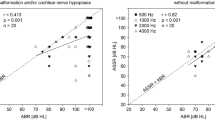Summary
This study aimes at investigating if the damped wavetrain stimulus (Victoreen) may be used in the evaluation of frequency specific thresholds using brainstem potentials. Stimulus frequencies were 1, 4, and 8 kHz. Starting with a control group (10 persons) latency curves for the brainstem potentials were established. The test group included patients with various forms of sensorineural hearing loss in the audiogram. Threshold measurements at the three stimulus frequencies were done with these patients using the potential IV (Jewett V). The latency curves of the normal hearing control group reveal a frequency-specific information being present in the brainstem potentials. This can be derived from latency shifts at different stimulus frequencies. However, investigating patients with a steep slope or a notch in the pure-tone audiogram introduces some difficulties in the ERA-threshold evaluation.
Zusammenfassung
Bei dieser Versuchsreihe wurde untersucht, ob bei Beschallung mit dem otometrischen Signal (damped wavetrain; DWT) eine frequenzspezifische Schwellenmessung mit den Hirnstammpotentialen möglich ist. Zu diesem Zwecke wurden erstens die Latenzkennlinien der Hirnstammpotentiale von zehn normalhörenden Versuchspersonen bei 1, 4 und 8 kHz erstellt, zweitens bei Patienten mit unterschiedlichem Innenohrschaden im Tonaudiogramm auch eine Schwellenmessung mit dem Hirnstammpotential IV (Jewett V) bei diesen drei Frequenzen durchgeführt. Die Ergebnisse zeigen, daß die Potentiale eine frequenzspezifische Information bei intaktem akustischem System enthalten. Dies kann anhand der Latenzverlängerung der Hirnstammpotentiale bei Änderung der Beschallungsfrequenz von 8 auf 4 und auf 1 kHz geschlossen werden. Bei dem Versuch einer frequenzspezifischen Schwellenmessung mit dem Hirnstammpotential IV bei Patienten mit steileren Abfällen und Senken im Tonaudiogramm ergaben sich aber Schwierigkeiten.
Similar content being viewed by others
Literatur
Brama I, Sohmer H (1977) Auditory nerve and brain stem responses to sound stimuli at various frequencies. Audiology 16:402–408
Brugge JF, Anderson DJ, Huid JE, Rose JE (1969) Time structure of discharges in single auditory nerve fibers of the squirrel-monkey in response to complex periodic sound. J Neurophysiol 32:386–401
Davis H, Hirsh SK (1976) The audiometric utility of brain stem responses to lowfrequency sounds. Audiology 15:181–195 (1976)
Davis H, Hirsh SK (1977) Brain stem electric response audiometry (BSERA). Acta Otolaryngol 83:136–139
Don M, Eggermont JJ (1978) Analysis of the click-evoked brainstem potentials in man using high-pass noise masking. J Acoust Soc Am 63:1084–1092
Don M, Eggermont JJ, Brackmann DE (1979) Reconstruction of the audiogram using brain stem responses and high-pass noise masking. Ann Otol Rhinol Laryngol (Suppl 57) 88:1–20
Evans EF (1975) The sharpening of cochlear frequency selectivity in the normal and abnormal cochlea. Audiology 14:419–442
Hecox K, Squires N, Galambos R (1976) Brainstem auditory evoked responses in man. I. Effect of stimulus rise-fall time and duration. J Acoust Soc Am 60:1187–1192
Jewett DL, Williston JS (1971) Auditory-evoked far fields averaged from the scalp of humans. Brain 94:681–696
Klein JA, Teas DC (1978) Acoustically dependent latency shifts of BSER (wave V) in man. J Acoust Soc Am 63:1887–1895
Kodera K, Yamane H, Yamada O, Suzuki JI (1977) Brain stem response audiometry at speech frequencies. Audiology 16:469–479
Mitchell C, Clemis JD (1977) Audiograms derived from the brain stem response. Laryngoscope 87:2016–2022
Picton TW, Ouellette J, Hamel G, Smith AD (1979) Brainstem evoked potentials to tonepips in notched noise. J Otolaryngol 8:289–314
Stecker M (1974) Einfluß der Click-Flankensteilheit auf die frühen Reizantworten des Hörsystems. Arch Otorhinolaryngol 206:225–234
Steele CR (1976) Cochlear mechanics. In: Keidel WD, Neff WD (eds) Handbook of sensory physiology, vol. V/3. Springer, Berlin Heidelberg New York, p 105–231
Terkildsen K, Osterhammel P, Huis in't Veld F (1975) Far field electrocochleography. Frequency specificity of the response. Scand Audiol 4:167–172
Victoreen JA (1973) Basic principles of otometry. Ch C Thomas Publ, Springfield, Ill.
Zöllner CH, Karhahl Th, Weigel K (1978) Elektrische Reaktionsaudiometrie (Hirnstammpotentiale und späte Potentialkomponente N1) bei Patienten mit Akustikusneurinom oder raumforderndem Prozeß im Bereich des Hirnstammes. Neurochirurgia 21:191–208
Author information
Authors and Affiliations
Rights and permissions
About this article
Cite this article
Zöllner, C., Pedersen, P. Problematik einer frequenzspezifischen Schwellenmessung mit den Hirnstammpotentialen unter Verwendung des otometrischen Signals (DWT). Arch Otorhinolaryngol 226, 259–268 (1980). https://doi.org/10.1007/BF00455587
Received:
Accepted:
Issue Date:
DOI: https://doi.org/10.1007/BF00455587




